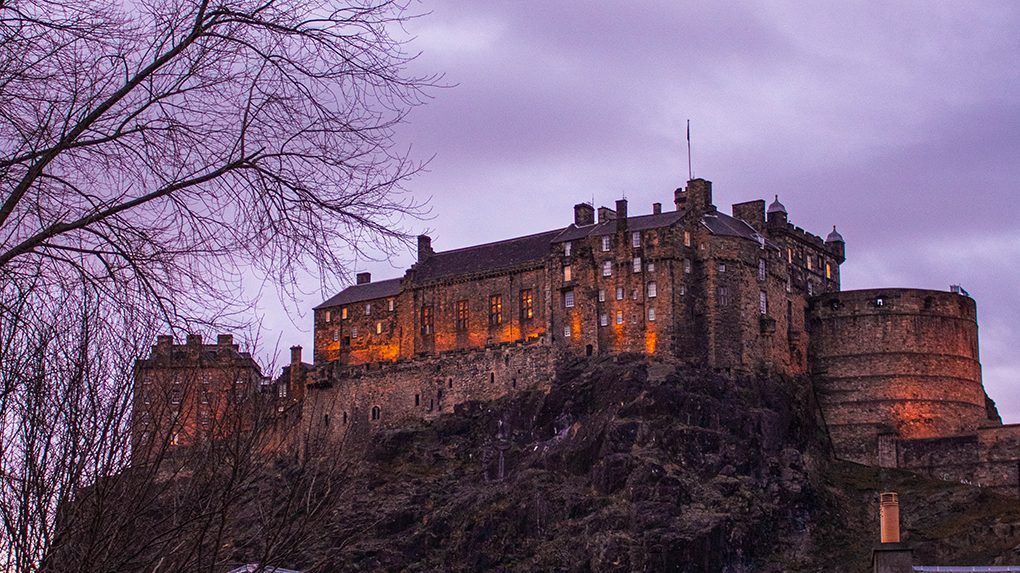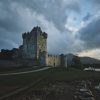Perched atop the rugged Castle Rock, Edinburgh Castle stands as a silent guardian of Scotland’s capital, holding within its ancient walls stories of valor, intrigue, and whispers of the supernatural.
As the castle’s shadow stretches across the city, it becomes clear: this fortress is not merely a monument of the past but also a keeper of countless mysteries, both historic and ghostly. Tracing its lineage back to the Iron Age, the castle’s presence has been a formidable one. As you approach, the journey up the winding Royal Mile brings an overwhelming sensation — a mix of awe and a tingle of something inexplicable. It’s a feeling that goes beyond the age-old stones and archways; it’s the castle’s storied past beckoning. Each crenellation, each tower, has borne witness to eras gone by, to tales of bravery and betrayal, and to legends of spirits that still roam the castle grounds.
In this exploration, we’ll delve deep into the heart of Edinburgh Castle, traversing its grand rooms and darkened corridors. We’ll recount its majestic history and also navigate its ghostly lore. From the ethereal Lady in White wandering near the Royal Palace to the eerie melodies of the Lost Piper Boy echoing through the labyrinthine tunnels, the castle’s reputation as one of the most haunted places in Scotland is as intriguing as its historical tales.
Beyond its spectral tales, the castle stands as a powerful emblem of Scotland’s rich heritage. Housing the Scottish National War Memorial and the National War Museum, it reminds visitors of the nation’s brave souls and their sacrifices. The castle, however, is not just about reliving the past; it’s a living testament to Scotland’s spirit – resilient, proud, and ever-evolving.
So, as we journey through the castle’s vast expanse, we urge you to feel, rather than merely observe. Imagine the resounding clang of medieval battles, the passionate debates within the Great Hall, and the silent footsteps of phantoms in torchlit passageways. In Edinburgh Castle, history and hauntings are intertwined, and to truly embrace its essence, one must tread the fine line between the known and the unknown.
A Brief Introduction to Edinburgh Castle
Ah, Edinburgh Castle! If you’ve not yet visited Edinburgh Castle, you’re in for an enchanting experience. And if you’ve been, you’re likely still reeling from its grandeur and the tales it hides. the castle boasts a complex building history that intertwines with the saga of Scotland itself. Perched atop Castle Rock, an extinct volcano no less, and a vital strategic point for whoever ruled the land. The name Edinburgh originates from ‘Din Eidyn’, which meant ‘Fortress on the Rock’ in the olden days. Over time, this fortress evolved into the magnificent castle we see today.
The Castle’s Historical Significance
Edinburgh Castle isn’t just a pretty face; it’s the embodiment of Scotland’s tumultuous history. Every stone, every alley whispers tales of kings, queens, battles, and betrayals.
While today’s castle exudes medieval charm, its roots plunge deep into the Iron Age. The first people to recognize the strategic importance of Castle Rock were the ancient tribes of the Iron Age. They set up a hill fort here, and although much of it has since been built over or eroded, their choice of location was undeniably brilliant. It’s as if they foresaw the castle’s rise to greatness (or maybe they just liked the view, who can tell?).
James IV, Mary Queen of Scots, and Other Royal Inhabitants: A Peek into the Royal Palace
Over the centuries, Edinburgh Castle has played host to a pantheon of Scottish royalty. James IV, David II, and the world-famous Mary, Queen of Scots – who not only held prisoners but also gave birth here! The Royal Palace within the castle preserves their legacy, housing treasures like the Crown Jewels and the historic Stone of Destiny. But more than these tangible artifacts, the walls are imbued with tales of love, loss, and intrigue.
The Great Siege and The Lang Siege: Tales of Battles and Bravery
A fortress as formidable as Edinburgh Castle was, naturally, a magnet for sieges. The Great Siege of 1333 saw David II’s forces clashing with the English. Fast forward a couple of centuries, and the Lang Siege of the late 16th century showcases the castle’s resilience against even the most persistent of foes. As you walk the grounds, it’s hard not to feel a profound respect for the Scots who defended their home against all odds.
Related: Where Do We Go After We Die? Theories on the Afterlife and Soul
Ghosts and Ghouls: Hauntings of Edinburgh Castle
Edinburgh Castle is not just a testament to Scotland’s turbulent history but also a repository of countless tales – some of them deeply eerie. From the echo of phantom footsteps to the restless spirits of ancient prisoners, this iconic fortress has had its fair share of spectral sightings.
The Lady in White: A Timeless Tale
Every old castle worth its salt has a tale of a lady in white, and Edinburgh Castle is no exception. Visitors, especially near the Royal Palace, have reported sightings of a mysterious woman dressed entirely in white. The twist in this tale? She’s said to have no face. Some believe she’s Janet Douglas, Lady Glamis, who was wrongly accused of witchcraft and burned at the stake in the 16th century. Since then, her spirit seems to be in eternal unrest, often seen wandering the castle’s old chambers and hallways.
The Lost Piper Boy: An Eerie Melody
One of the most enduring legends of the castle revolves around a young piper boy. As the story goes, he was sent into the castle’s labyrinthine tunnels to investigate their depth and direction. To trace his path, he played his pipes loudly. However, the music suddenly stopped, and the boy was never seen again. To this day, some visitors claim to hear the faint sound of pipes emanating from the depths of the castle, believed to be the young piper still trying to find his way out.
The Headless Drummer: Marching to an Eternal Beat
History and legends often intermingle at Edinburgh Castle. One such tale is of the headless drummer boy. First sighted before Oliver Cromwell’s attack on the castle in 1650, the drummer is considered an omen of impending doom. Though the story might be rooted in trying to instill fear in the hearts of the castle’s defenders, the ghostly beat of a drum is still reported on occasion, especially on stormy nights.
The Haunted Dungeons: Echoes of Despair
The dungeons of Edinburgh Castle have seen countless prisoners over the centuries, from French soldiers during the Seven Years’ War to colonial prisoners from the American Revolutionary War. The anguish and despair of these confined souls still resonate in the chilling air of the dungeons. Visitors have reported strange phenomena here, from sudden drops in temperature to unexplained mists. Some have even claimed to be touched by invisible hands or to hear heart-wrenching sobs in empty cells.
Ghostly Battleground: The Argyll Battery
The Argyll Battery, once the scene of intense battles, has its own spectral tales. Soldiers in antique uniforms are occasionally seen manning the battlements, holding their positions even in death. Some speculate that these spirits are of soldiers who died defending the castle and now continue their watch in the afterlife.
Apparitions in St. Margaret’s Chapel
The oldest surviving building in Edinburgh, St. Margaret’s Chapel, is a sanctuary of peace. However, there have been tales of ghostly apparitions within its walls. Some speak of a benevolent presence, a comforting aura, believed to be the spirit of Queen Margaret herself, ensuring her beloved chapel remains a haven.
The Ghostly Dog of the Dog Cemetery
The castle’s Dog Cemetery, a resting place for regimental mascots and officers’ dogs, has its own eerie tales. Visitors have spoken of seeing a ghostly dog, wandering restlessly, possibly waiting for its master to return. This ethereal canine is a testament to the deep bonds formed in times of war, bonds that seemingly persist beyond death.
The Architectural Wonders of Edinburgh Castle
The castle isn’t just a beacon of Scottish history, but also a marvel of architectural evolution. Over the ages, the castle grew from a modest hill fort to a sprawling citadel, showcasing the artistic and strategic sensibilities of various eras.
The Oldest Building: St Margaret’s Chapel
Among the structures in Edinburgh Castle, St Margaret’s Chapel stands out, not just because of its architectural beauty, but because it’s the oldest surviving building in Edinburgh. Built in the early 12th century, this modest yet charming chapel was dedicated to Queen Margaret, later canonized as Saint Margaret of Scotland. Stepping inside feels like a journey back in time, where the weight of centuries hangs in the air, yet there’s a serenity that promises eternal calm.
Towering Triumphs: David’s Tower and The Half Moon Battery
David’s Tower, named after King David II, was once a prominent feature of Edinburgh Castle, and while much of it lies hidden beneath the Half Moon Battery due to reconstructions after the Lang Siege, its remnants are a testament to its former glory.
The Half Moon Battery, with its crescent shape and imposing cannons, is not just a defensive structure but also a symbol of the castle’s resilience. Overlooking the city, this battery stands as a reminder of the lengths the Scots went to protect their beloved Edinburgh.
The Great Hall: A Hallway to Scottish History
Constructed under the reign of James IV, the Great Hall boasts a magnificent wooden roof, medieval weapons, and armor displays. It once reverberated with the sounds of feasts, dances, and celebrations. Today, while the festivities might be fewer, the hall remains a vibrant testament to Scotland’s rich cultural legacy. It’s the sort of place where you half expect to bump into a knight returning his borrowed audio guide after a self-led tour!
Scotland’s Treasures: Housed in the Castle
While the castle is itself a treasure, the artifacts and stories it houses elevate its significance multifold. From the glitter of the crown jewels to the boom of Mons Meg, there’s a tale behind every artifact.
The Crown Jewels: Shining Stars of the Royal Scots
Tucked securely within the Royal Palace is the Crown Room, home to Scotland’s Crown Jewels. The dazzling crown, sceptre, and sword of state have not only adorned monarchs but have also played a role in the coronation ceremonies of kings and queens. The fact that they were hidden away during the Second World War, only to be rediscovered later, adds a touch of mystery to their already captivating history.
Mons Meg: The Castle’s Very Own Cannon
Every castle needs a cannon, right? But Mons Meg isn’t just any cannon. This medieval bombard, a gift from Duke Philip of Burgundy to James II, is capable of firing stones weighing 150kg! While she’s now retired from active duty, her formidable presence still draws visitors from across the globe.
Scottish National War Memorial: A Salute to the Brave
Dedicated to the Scots who sacrificed their lives in World War I, the Scottish National War Memorial is both poignant and beautiful. It’s not just a place of remembrance, but also an architectural marvel, seamlessly blending with the castle’s ancient stones.
The One O’Clock Gun: Timekeeping the Scottish Way
One of the castle’s quirkiest traditions is the firing of the One O’Clock Gun. A world away from the digital pings of today’s smartphone alerts, this auditory boom has been echoing since 1861, helping the city’s residents set their time. And it’s not just for show; the gun serves as a tribute to the city’s maritime history. If you’re at the castle at the right time, don’t miss this ear-splitting experience. Just a tip – you might want to cover your ears!
The Broader Landscape: Exploring Beyond the Castle Walls
Edinburgh Castle might dominate the skyline, but the surrounding areas are equally deserving of exploration. From the bustling Royal Mile to the quiet nooks that house centuries-old tales, venturing beyond the castle promises added delights.
The Royal Mile: A Journey Through Edinburgh’s Heart
Stretching from the castle gates to the Palace of Holyroodhouse, the Royal Mile is Edinburgh’s historic spine. Cobbled streets, narrow alleyways, and historic buildings flank this bustling stretch, offering a myriad of shopping, dining, and entertainment options. It’s said that a walk down the Royal Mile is a walk through time. And, given the occasional street performer dressed as a medieval jester, sometimes, time seems to have a sense of humor!
Exploring Castlehill: Echoes of the Ancient
Castlehill, the volcanic ridge upon which the castle stands, is replete with its own tales. From ancient settlements to remnants of old fortifications, Castlehill offers glimpses of eras gone by.
The Grassmarket: Tales of Markets and Hangings
Once a bustling marketplace and, unfortunately, a site for public executions, the Grassmarket area is now a vibrant hub, dotted with cafes, shops, and pubs. Its historic charm, combined with modern vibrancy, makes it a must-visit.
The Castle Rock: Geological Majesty and Mysteries
When admiring the might and majesty of Edinburgh Castle, it’s easy to overlook the very foundation it stands upon. Castle Rock, the extinct volcano that lends the castle its elevated and strategic position, is a marvel in its own right.
A Glimpse into Deep Time: Formation and History
Castle Rock began its journey around 340 million years ago as an active volcano. Over time, as the volcano became extinct, the softer surrounding rocks eroded away, leaving behind the hardy basalt core. This rugged foundation eventually became the site for one of the most iconic castles in Western Europe. Today, geology enthusiasts and curious visitors alike marvel at Castle Rock’s exposed sections. These ancient rock faces not only provide a glimpse into Earth’s tumultuous past but also serve as a reminder of nature’s awe-inspiring power.
Strategic Importance: Castle Rock’s Role in Defense
The very geography of Castle Rock made it a prime spot for fortification. Its steep cliffs provided a natural defense against invaders. Throughout history, from the Iron Age settlements known as Din Eidyn to the present-day fortress, Castle Rock has been integral to the castle’s security.
You may also like The Ancient Ram Inn A Haunted House with a Dark Past
Military Museums: A Tribute to Scotland’s Bravehearts
Edinburgh Castle isn’t just about royals and regents. It’s also a testament to the valor of countless soldiers who defended Scotland’s honor.
The National War Museum: Chronicles of Valor
Located within the castle’s walls, the National War Museum delves into over 400 years of Scotland’s military history. From the brave exploits of the Royal Scots to the poignant tales of soldiers in the World Wars, the museum offers a comprehensive look into the sacrifices and victories of Scottish warriors.
Apart from the National War Museum, the castle also houses several regimental museums. These focus on specific regiments, providing in-depth insights into their histories, traditions, and contributions.
Experiencing Edinburgh Castle Today
Planning a visit to one of the most exciting historic sites in Western Europe? How does one truly experience Edinburgh Castle today? With modern amenities mingling with ancient structures, the castle offers a unique blend of the old and the new.
Castle Tickets: Ensuring Your Entry
Edinburgh Castle can get quite busy, especially during peak tourist season. To avoid lengthy queues and potential disappointment, it’s wise to pre-book your tickets online. Not only do you get the best price, but online booking also often includes skip-the-line privileges. Pre-book your tickets online to guarantee entry. While there’s a ticket office at the castle, booking ahead often saves you from the long queues, especially during peak seasons.
There are several ticket options to choose from: individual tickets, family tickets, and those for HM Forces. Oh, and a heads-up for history enthusiasts – members of Historic Scotland get free entry!
If you’re someone who likes to delve deep into history at your own pace, audio guides are available in multiple languages. They lead you through the castle, regaling tales of yore, ensuring you don’t miss out on any detail.
However, if you’re looking to have a more interactive experience, consider joining a guided tour. Led by experts who know the castle like the back of their hand (or perhaps like a friendly ghost they chat with during coffee breaks?), these tours offer insights and anecdotes that bring the castle’s history to life.
Castle Activities and Events: Immersion Through Interaction
Historic Environment Scotland, the body responsible for overseeing Edinburgh Castle, does a phenomenal job of ensuring that the castle isn’t just a relic of the past but a vibrant, living testament to Scottish history and culture.
Re-enactments: Reliving the Past
Throughout the year, the castle hosts various re-enactments, bringing key moments of Scotland’s history to life. From battles to royal ceremonies, these events allow visitors to step back in time. Imagine witnessing a re-enactment of the Lang Siege or the arrival of Mary Queen of Scots after her return from France. It’s not just history; it’s an experience!
Festive Celebrations: Tradition Meets Revelry
The castle, with its historic backdrop, serves as the perfect venue for traditional Scottish celebrations. From Hogmanay, the Scottish New Year celebration, to the vibrant Beltane Fire Festival, these events blend history with festivity, ensuring visitors get a taste of Scotland’s rich cultural tapestry.
Dining at the Castle: A Culinary Journey
Hungry after your castle exploration? The on-site cafes and restaurants offer everything from traditional Scottish dishes to contemporary fare. And, of course, there’s always a generous helping of Scottish hospitality on the side!
Edinburgh Castle parting Thoughts: Echoes of History and Hauntings
As our exploration of Edinburgh Castle draws to a close, one thing becomes evident: this magnificent fortress is more than just stone and mortar; it’s a chronicle of Scotland’s dynamic capital city, an emblem of its resilience, and a testament to its rich heritage. A living tapestry of Scotland’s vibrant history, enriched with tales of bravery, love, betrayal, and yes, the unexplained.
Walking its ancient corridors, one can’t help but feel the weight of countless centuries pressing down. From the battle cries of warriors defending their homeland to the whispered prayers in St. Margaret’s Chapel, the castle resonates with the echoes of the past. But intertwined with these historical accounts are the chilling tales of spirits who, it seems, have chosen to make the castle their eternal abode. The mysterious Lady in White, the mournful melodies of the Lost Piper Boy, the ghostly drumbeats that foretell danger — these tales add a layer of intrigue to the castle’s already rich narrative. Whether you’re a firm believer in the supernatural or a skeptic, the sheer number of accounts and the consistency of sightings can give even the staunchest doubters pause for thought.
Edinburgh Castle stands as a testament to the enduring spirit of Scotland — its resilience in the face of adversities, its pride in its storied past, and its openness to the mysteries of the beyond. It’s a place where history meets legend, where tales of heroism coexist with ghostly whispers, creating an experience that’s both profound and eerie. So, as you depart from this iconic landmark and the sounds of the One O’Clock Gun fade into the distance, carry with you not just memories of a historical tour but also tales of the otherworldly. And remember, every shadow, every creak might just be a silent witness from another era, waiting to share their story.



